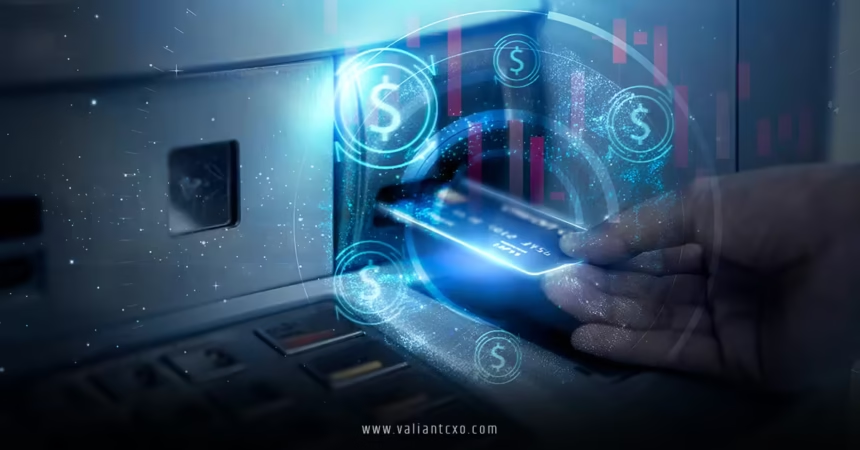The Future of US ATM Networks in a Cashless World is a topic buzzing with intrigue as digital payments soar and cash usage dwindles. Picture this: you’re standing at an ATM, fumbling for your card, while your phone pings with a notification about a seamless mobile payment you just made. It’s a scene that makes you wonder—do ATMs still have a place in a world racing toward cashless transactions? With digital wallets like Apple Pay and cryptocurrencies like Bitcoin gaining traction, the role of ATMs in the US is at a crossroads. Yet, despite the digital wave, these cash-dispensing machines are far from obsolete. Let’s dive into what the future holds for US ATM networks, exploring their evolution, challenges, and surprising new roles in a cashless society.
Why Are We Talking About The Future of US ATM Networks in a Cashless World?
The shift toward a cashless world isn’t just a trend; it’s a seismic shift in how we handle money. Mobile apps, contactless cards, and even QR codes are making cash feel like a relic from a bygone era. In 2022, digital payments penetration hit 89%, with 62% of consumers using multiple digital payment methods. But here’s the kicker: cash still accounts for 60% of transactions under $10 in the US. So, while the cashless wave is strong, it hasn’t drowned out cash entirely. This duality raises a big question: how will US ATM networks adapt to stay relevant? The Future of US ATM Networks in a Cashless World hinges on their ability to evolve beyond just spitting out cash.
The Cashless Surge: What’s Driving It?
Imagine a world where you never need to carry cash—your phone is your wallet, and every transaction is a tap away. That’s the dream of a cashless society, fueled by convenience, speed, and technology. The COVID-19 pandemic accelerated this shift, with fears of cash spreading germs pushing retailers toward contactless payments. Countries like Sweden, where only 1% of payments are cash, show what’s possible. In the US, digital wallets and apps like Venmo are household names, and even Gen Z is jumping on trends like “cash stuffing” on TikTok, blending old-school cash with modern flair. But for every digital convert, there’s an unbanked or underbanked American—26% of the population, to be exact—who relies on cash. This tension shapes The Future of US ATM Networks in a Cashless World.
The Persistent Power of Cash
Cash is like that old friend who never quite leaves your side, no matter how many new pals you make. It’s reliable, universally accepted, and works when the power goes out or the internet crashes. For small businesses, low-income communities, and even industries like cannabis dispensaries (where federal regulations block card payments), cash is king. ATMs remain the lifeline for these groups, providing access to physical currency when digital options fall short. The ATM Industry Association (ATMIA) reported 520,000 to 540,000 active ATMs in the US in 2022, a number that’s growing despite the cashless push. So, while digital payments dominate headlines, cash—and by extension, ATMs—still has a pulse.
How Are US ATM Networks Evolving in a Cashless World?
The Future of US ATM Networks in a Cashless World isn’t about clinging to the past but embracing innovation. ATMs are no longer just cash dispensers; they’re becoming mini-banking hubs, blending physical and digital experiences. Let’s explore how these machines are reinventing themselves to stay relevant.
From Cash Machines to Multifunctional Hubs
Think of ATMs as the Swiss Army knives of banking. Sure, they dispense cash, but modern ATMs do so much more. Interactive Teller Machines (ITMs) are a game-changer, offering video connections to live tellers who can handle complex transactions like loan applications or account openings. Banks like PNC and Bank of America are deploying ITMs to extend branch services without the overhead of physical branches. These machines support multiple languages and operate longer hours, making banking accessible to diverse communities. The Future of US ATM Networks in a Cashless World lies in this shift toward versatility, turning ATMs into self-service kiosks that bridge the gap between digital and physical banking.
Cash Recycling: A Cost-Saving Revolution
Ever wonder what happens to the cash you deposit at an ATM? In the past, it sat in a vault until a truck hauled it away. Now, cash recycling ATMs are flipping the script. These machines reuse deposited cash for withdrawals, cutting down on cash-in-transit costs. With cash operations eating up to 10% of banks’ operating budgets, this is a big deal. About 37% of banks plan to implement cash recycling, according to industry surveys. By reducing the need for frequent refills, these ATMs make networks more efficient and sustainable, a key factor in The Future of US ATM Networks in a Cashless World.
AI and Personalization: The Smart ATM Era
Artificial intelligence is sneaking into ATMs, and it’s not just sci-fi hype. Imagine an ATM greeting you by name, suggesting your usual transactions, or even offering personalized loan ads based on your banking history. AI is making this a reality, with 9% of banks already using it and 18% planning to adopt it soon. AI enhances security by detecting fraud, optimizes cash management with predictive analytics, and tailors user experiences to match mobile banking apps. This tech infusion ensures The Future of US ATM Networks in a Cashless World is smart, secure, and customer-focused.
Challenges Facing The Future of US ATM Networks in a Cashless World
No transformation comes without hurdles. As US ATM networks navigate a cashless world, they face regulatory, security, and societal challenges that could make or break their future.
Regulatory Pressures and Compliance Costs
Regulations are like speed bumps on the road to innovation. The Payment Card Industry Security Standards Council (PCI SSC) mandated that ATMs upgrade to the latest encrypting PIN pads and TR31 Phase 3 key blocks by January 2025. Non-compliant machines risk losing transaction functionality, forcing banks to invest heavily in upgrades. On top of that, proposed legislation like ATM fee caps or EBT fee eliminations in states like New York could squeeze operators’ profits. These rules aim to protect consumers but may lead to unintended consequences, like fewer ATMs accepting EBT cards. Navigating these regulations is critical to The Future of US ATM Networks in a Cashless World.
Rising Security Threats
ATMs are like honey pots for criminals, attracting both physical and digital attacks. Physical tampering, like “jackpotting” (forcing ATMs to spit out cash), and cyberattacks, like malware, are on the rise. A single failed attack can cost thousands to repair, and a successful one could compromise an entire network. Banks are fighting back with bill validation technology and multi-layered fraud detection, but staying ahead of criminals is a constant battle. Security will shape The Future of US ATM Networks in a Cashless World, as trust is non-negotiable in banking.
The Digital Divide and Accessibility
A cashless world sounds sleek, but it’s not inclusive. The 26% of Americans who are unbanked or underbanked often lack access to digital payment tools. Rural areas with spotty internet or elderly folks uncomfortable with apps rely on ATMs for financial access. Closing ATMs to cut costs could disenfranchise these groups, deepening financial inequality. The Future of US ATM Networks in a Cashless World must balance efficiency with inclusivity, ensuring no one is left behind.
Opportunities for US ATM Networks in a Cashless World
Despite the challenges, The Future of US ATM Networks in a Cashless World is brimming with opportunities. From new services to strategic partnerships, ATMs are poised to carve out a unique niche.
Expanding Services Beyond Cash
ATMs are stepping up their game, offering services like mobile top-ups, bill payments, and even cryptocurrency transactions. In countries like Italy, ATMs let you pay taxes or buy event tickets. In the US, banks like JPMorgan Chase are exploring similar expansions, turning ATMs into one-stop financial hubs. By integrating with digital wallets or offering cardless withdrawals, ATMs can stay relevant even as cash use declines. This versatility is a cornerstone of The Future of US ATM Networks in a Cashless World.
Shared Networks and Cost Optimization
Why go it alone when you can team up? Shared ATM networks, where banks pool resources, are gaining traction. This approach cuts costs while maintaining a physical presence in communities. About 39% of banks see ATMs as tools for diverse transactions, and shared networks amplify this potential. By collaborating, banks can optimize ATM placement using data analytics, ensuring machines are where they’re needed most. This strategy is key to The Future of US ATM Networks in a Cashless World.
Retail Media and Advertising
Here’s a wild idea: ATMs as advertising platforms. With screens already in place, ATMs can display targeted ads based on user data, creating a new revenue stream. Imagine an ATM suggesting a nearby coffee shop or a car loan tailored to your needs. Companies like NCR Atleos are exploring this, leveraging ATMs’ foot traffic to deliver retail media. This innovative approach could redefine The Future of US ATM Networks in a Cashless World, turning cash machines into marketing powerhouses.
The Role of ATMs in Financial Inclusion
The Future of US ATM Networks in a Cashless World isn’t just about tech—it’s about people. ATMs play a vital role in serving the unbanked and underbanked, who often face barriers to digital banking. In low-income neighborhoods or rural areas, ATMs provide a lifeline to cash for daily needs like groceries or rent. They also support small businesses that rely on cash transactions. By maintaining and modernizing ATM networks, banks can ensure financial inclusion, making The Future of US ATM Networks in a Cashless World a story of equity as much as innovation.
Conclusion
The Future of US ATM Networks in a Cashless World is a tale of adaptation and resilience. While digital payments are reshaping how we transact, ATMs are far from fading away. They’re evolving into multifunctional hubs, leveraging AI, cash recycling, and new services to stay relevant. Challenges like regulations, security threats, and the digital divide loom large, but opportunities in shared networks, expanded services, and retail media offer a bright path forward. For the 26% of Americans who rely on cash, ATMs remain a vital link to financial access. As we move toward a cashless future, US ATM networks will continue to innovate, ensuring they’re not just surviving but thriving. So, next time you pass an ATM, don’t dismiss it as a relic—see it as a bridge to a dynamic financial future.
FAQs
1. How will The Future of US ATM Networks in a Cashless World impact small businesses?
Small businesses, especially in cash-heavy industries like retail or cannabis, will continue to rely on ATMs for cash access. Modern ATMs offering services like bill payments or mobile top-ups can also attract customers, boosting foot traffic.
2. Are ATMs becoming obsolete in a cashless society?
Not quite! While digital payments are growing, The Future of US ATM Networks in a Cashless World involves adapting with features like ITMs, cash recycling, and AI to serve diverse needs, ensuring ATMs remain relevant.
3. What role does AI play in The Future of US ATM Networks in a Cashless World?
AI enhances ATMs with personalized user experiences, fraud detection, and predictive cash management. About 9% of banks already use AI, with more planning to adopt it, making ATMs smarter and more efficient.
4. How can ATMs support financial inclusion in a cashless world?
ATMs provide cash access for the 26% of unbanked or underbanked Americans, especially in rural or low-income areas. The Future of US ATM Networks in a Cashless World includes maintaining these machines to bridge the digital divide.
5. What are the security challenges for The Future of US ATM Networks in a Cashless World?
ATMs face physical attacks like jackpotting and cyberattacks like malware. Banks are countering with bill validation and multi-layered fraud detection to ensure secure transactions.
For More Updates !! : valiantcxo.com


